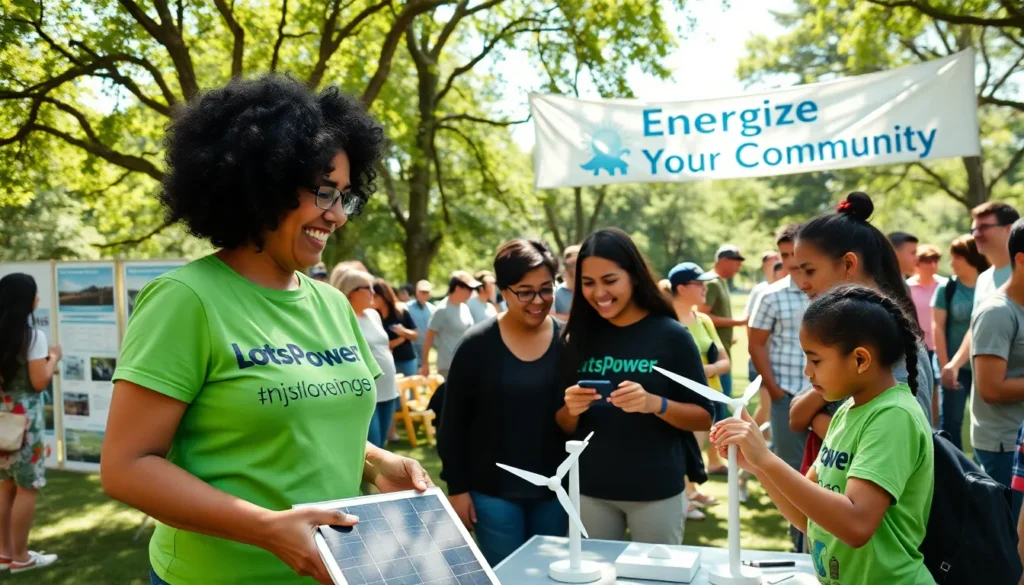Table of Contents
ToggleIn today’s fast-paced world, the need for sustainable energy solutions has become more pressing than ever. Communities across the globe are recognizing the importance of harnessing local energy resources to not only power homes but also to create a resilient and thriving environment. By focusing on community energy needs and utilizing renewable sources, organizations like LotsOfPower are leading the charge towards a more sustainable future. This article delves into how communities can energize themselves, highlighting practical strategies and inspiring success stories along the way.
Understanding Community Energy Needs

Every community has specific energy requirements based on its size, demographics, and existing infrastructure. Understanding these needs is crucial for developing effective energy strategies. Community leaders should start by conducting a comprehensive energy audit that evaluates current energy consumption patterns. This audit can reveal not only the total energy needs but also identify inefficiencies in usage and potential areas for improvement. Also, considerations such as socioeconomic factors, local industries, and community activities can provide insight into how energy is consumed, helping to tailor solutions that are efficient and impactful.
The Role of Renewable Energy
Renewable energy sources such as solar, wind, and hydroelectric power are at the forefront of the movement toward sustainable community energy solutions. Transitioning to renewable energy can drastically reduce a community’s carbon footprint while promoting energy independence. For example, solar panels installed on community buildings can generate power locally, decreasing reliance on fossil fuels. Wind turbines can complement solar initiatives, particularly in areas with favorable wind patterns. Also, investing in renewable energy not only provides environmental benefits but also stimulates local economies by creating jobs in the installation and maintenance of renewable energy systems.
Building a Sustainable Energy Infrastructure
To support the transition to renewable energy, communities need to invest in sustainable energy infrastructure. This includes developing smart grids that can efficiently distribute energy generated from diverse sources, enhancing storage capabilities to ensure a steady energy supply, and incentivizing energy-efficient building designs. Also, incorporating community-based energy projects, such as neighborhood solar cooperatives or local wind farms, can empower residents and ensure they play an integral role in the energy landscape. Collaboration between local governments, businesses, and residents is vital to developing an infrastructure that is resilient, efficient, and sustainable for future generations.
Engaging Community Members
Engagement is key when it comes to energizing a community. Initiatives that educate and involve residents in energy conservation and sustainability practices can foster a sense of ownership and responsibility towards energy resources. Workshops, community meetings, and educational campaigns can provide vital information on energy efficiency and renewable technologies. Also, engaging local schools and organizations in energy projects can establish long-term habits about energy use. By creating opportunities for community members to contribute ideas or volunteer for initiatives, they become stakeholders in their community’s energy future, enhancing the collective effort towards sustainable practices.
Success Stories: Communities Transformed
Several communities offer inspiring examples of successful energy transformations. For instance, the town of San Diego, California, has made significant strides in solar energy integration, achieving over 100 megawatts of installed solar capacity. This initiative not only reduced local energy costs but also established San Diego as a leader in renewable energy. Similarly, the residents of Greensburg, Kansas, rebuilt their town after a devastating tornado with a focus on renewable energy. By utilizing wind farms and energy-efficient buildings, they turned a disaster into an opportunity for sustainable growth, attracting new businesses and residents. These examples show that with determination and collaboration, communities can achieve remarkable progress toward sustainable energy solutions.
Future Trends in Community Energy Solutions
As technology evolves, so do community energy solutions. Smart technology, such as advanced metering systems and IoT devices, is poised to revolutionize how communities manage energy consumption. Also, community energy storage solutions are becoming more feasible, enabling residents to store excess energy generated from renewable sources for later use. Emerging trends also include peer-to-peer energy trading, where residents can buy and sell energy with one another, further democratizing energy systems. These innovations present exciting opportunities for communities to enhance their resilience and independence while decreasing environmental impact.
Conclusion
Energizing a community through sustainable energy solutions is not only a necessity but a responsibility for future generations. By understanding local energy needs, embracing renewable energy, constructing resilient infrastructures, engaging community members, and learning from successful transformations, communities can create a sustainable future. Organizations like LotsOfPower are leading the way, but it requires collective effort from individuals, communities, and governments. The path to a greener, more empowered community is clear, and the time to act is now.




